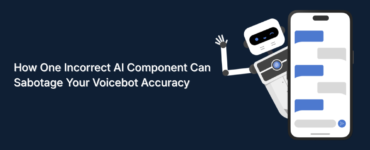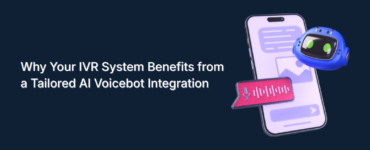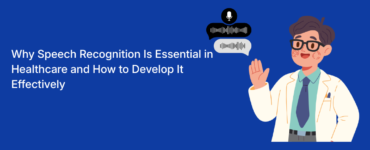New and improved Artificial Intelligence (AI) techniques—driven by leaps in computing power—are enabling machines to learn, adapt, and deliver outcomes with minimal human supervision. The healthcare sector, already teeming with high-impact use cases, is one of the most promising beneficiaries of this AI wave.
According to WHO, the global healthcare system is facing a shortage of 4.3 million doctors, nurses, and health workers. In India alone, there’s a shortfall of 600,000 doctors and 2 million nurses. This growing gap threatens not just access but also the quality of care. In response, emerging technologies—particularly Conversational AI in Healthcare—are lighting a path forward by easing the burden on medical professionals and improving service accessibility.
From primitive tools to robotic surgeries and advanced telemedicine, healthcare has always evolved with innovation. Now, Conversational AI is set to redefine its future. A report by Accenture estimates that AI-powered healthcare applications can generate annual savings of $150 billion by 2026 in the U.S. alone. This guide explores how Conversational AI in Healthcare—including AI chatbots in healthcare, healthcare automation, and virtual health assistants—is transforming the industry from the inside out.
1. Addressing the Healthcare Workforce Crisis
With medical professionals stretched thin globally, Conversational AI in Healthcare offers a scalable solution. AI chatbots and virtual assistants can handle high volumes of routine queries, conduct initial symptom assessments, and assist in patient triage—functions that would otherwise consume doctors’ and nurses’ time.
These bots can interact in multiple languages, making them invaluable in multilingual populations like India’s. For instance, a conversational AI tool can ask patients about symptoms, duration, and severity, and based on inputs, escalate only critical cases to physicians. This reduces unnecessary clinic visits and optimizes doctors’ schedules, especially in primary care settings.
By offloading repetitive and non-critical tasks, AI supports frontline workers in focusing on tasks that require deep clinical expertise, mitigating burnout and increasing patient throughput.
2. Streamlining Administrative Workflows
Administrative overload is one of the leading causes of inefficiency in healthcare delivery. Doctors spend a significant portion of their time—up to 40%—on documentation and non-clinical tasks. This is where healthcare automation through Conversational AI makes a significant impact.
AI-powered systems can schedule appointments, send reminders, handle insurance queries, verify patient data, and even manage prescription renewals. For example, a hospital chatbot can confirm patient identity, collect insurance details, and provide updates about coverage—all without staff involvement.
Hospitals that implement Conversational AI report shorter wait times, faster onboarding, and fewer missed appointments. This not only boosts internal efficiency but also enhances the patient experience.
3. Enhancing Patient Engagement and Communication
Today’s patients expect convenience, clarity, and continuous communication. Conversational AI helps providers meet these expectations by offering personalized, real-time interactions 24/7.
AI chatbots in healthcare can explain lab results, provide follow-up instructions, or remind patients to take their medication—improving adherence and reducing the risk of readmission. These systems can also collect feedback, allowing hospitals to improve services based on actual patient sentiments.
Moreover, these tools are capable of engaging patients across multiple touchpoints—mobile apps, websites, SMS, or even voice calls—creating an omnichannel experience. By being always available and hyper-responsive, virtual health assistants help create a more supportive and trustworthy patient journey.
4. Supporting Clinicians with Intelligent Tools
Doctors and nurses often face information overload, particularly in environments like emergency departments. Conversational AI in Healthcare can act as a digital co-pilot, supporting clinical decision-making in real time.
These tools gather patient data, summarize symptoms, and even suggest differential diagnoses based on best medical practices. While not a replacement for clinical judgment, they significantly reduce diagnostic errors and streamline data access.
In addition, AI scribes can transcribe and summarize consultations, freeing up physicians from tedious EMR documentation. According to a study published in the Journal of Medical Systems, AI scribes have the potential to save doctors up to 2 hours per day, which can be redirected to patient care or continuing education.
5. Managing Chronic Diseases with Real-Time Assistance
Chronic disease management often requires continuous engagement, monitoring, and education. This is where virtual health assistants truly shine. These intelligent systems can:
- Send daily health check-ins
- Track glucose levels, blood pressure, or other vitals
- Recommend lifestyle adjustments
- Alert healthcare providers if anomalies are detected
For example, a diabetic patient could receive reminders to log their blood sugar and get immediate dietary tips based on their input. The system can escalate any red flags to a care coordinator or physician.
Such personalized and ongoing interaction reduces complications, prevents hospitalizations, and empowers patients to actively manage their health.
6. Scaling Telehealth and Remote Care
With the rise of telemedicine, Conversational AI is becoming essential to scale services without sacrificing quality. AI chatbots in healthcare serve as the first point of contact in digital consultations, helping assess symptoms, collect history, and prepare patients for virtual visits.
Post-consultation, these bots can guide patients through their treatment plan, help them book follow-ups, and even answer clarifying questions about prescriptions.
This seamless integration of virtual care with intelligent assistants ensures that remote consultations are not rushed, fragmented, or impersonal. It also allows providers to serve more patients efficiently, especially in areas with limited medical infrastructure.
Conclusion: The Path Forward
The healthcare industry is under constant pressure—from staff shortages to growing patient demands. That’s where Conversational AI in Healthcare comes in. It’s not just a trend—it’s a practical solution helping hospitals, clinics, and patients every day.
AI chatbots now handle routine questions, schedule appointments, and support patients 24/7. Virtual health assistants help manage chronic conditions, remind patients to take medications, and keep doctors informed. Meanwhile, healthcare automation is streamlining admin work, cutting costs, and reducing burnout for medical staff.
What makes this technology so powerful is its ability to scale and adapt—especially when combined with telehealth, wearables, and patient data. It helps shift healthcare from being reactive to proactive.
Of course, implementation needs to be thoughtful, with strong data privacy and human oversight. But when used right, conversational AI doesn’t just make healthcare more efficient—it makes it more human.
Frequently Asked Questions (FAQs)
1. What is Conversational AI in Healthcare?
Conversational AI in Healthcare refers to the use of AI-powered tools—like chatbots, virtual assistants, and voice-based systems—to interact with patients, automate administrative tasks, and support healthcare professionals. These tools can communicate in natural language, offering 24/7 assistance and improving both efficiency and patient experience.
2. How are AI chatbots used in healthcare settings?
AI chatbots in healthcare are commonly used for appointment scheduling, answering FAQs, sending medication reminders, conducting symptom checks, and guiding patients through follow-up care. They reduce the workload on medical staff and provide instant support to patients.
3. Can Conversational AI help with chronic disease management?
Yes. Virtual health assistants can monitor patients with chronic conditions like diabetes or heart disease by checking symptoms, collecting daily health data, sending reminders, and even alerting care teams when intervention is needed. This helps in preventing complications and improving long-term outcomes.
4. Is Conversational AI replacing doctors or nurses?
No. Conversational AI is designed to support—not replace—healthcare professionals. It handles repetitive or routine tasks so that doctors and nurses can focus on critical decision-making and patient care. Human oversight is still essential for diagnosis and treatment.
5. What are the risks or challenges of using AI in healthcare?
Like any technology, there are challenges—such as ensuring data privacy, preventing bias in AI responses, and maintaining accuracy in patient communication. Successful implementation requires careful planning, ethical oversight, and compliance with healthcare regulations like HIPAA or GDPR.




